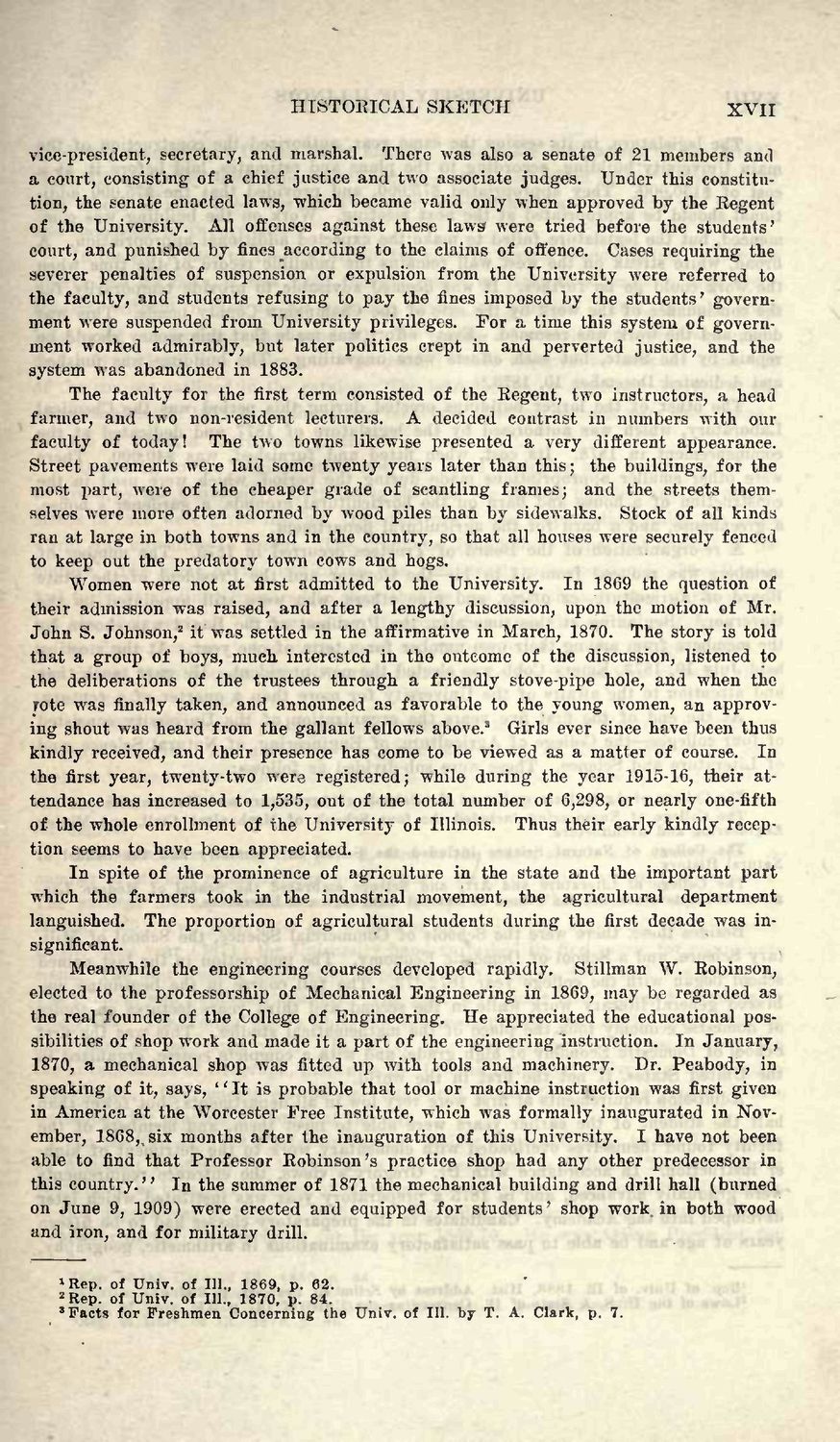| |
| |
Caption: Book - Early History of University (1916)
This is a reduced-resolution page image for fast online browsing.

EXTRACTED TEXT FROM PAGE:
HISTORICAL SKETCH XVII vice-president, secretary, and marshal. There was also a senate of 21 members and a court, consisting of a chief justice and two associate judges. Under this constitution, the senate enacted laws, which became valid only when approved by the Kegent of the University. All offenses against these laws' were tried before the students' court, and punished by fines according to the claims of offence. Cases requiring the severer penalties of suspension or expulsion from the University were referred to the faculty, and students refusing to pay the fines imposed by the students' government were suspended from University privileges. For a time this system of government worked admirably, but later politics crept in and perverted justice, and the system was abandoned in 1883. The faculty for the first term consisted of the Eegent, two instructors, a head farmer, and two non-resident lecturers. A decided contrast in numbers with our faculty of today! The two towns likewise presented a very different appearance. Street pavements were laid some twenty years later than this; the buildings, for the most part, were of the cheaper grade of scantling frames; and the streets themselves were more often adorned by wood piles than by sidewalks. Stock of all kinds ran at large in both towns and in the country, so that all houses were securely fenced to keep out the predatory town cows and hogs. Women were not at first admitted to the University. In 1809 the question of their admission was raised, and after a lengthy discussion, upon the motion of Mr. John S. Johnson, 2 it was settled in the affirmative in March, 1870. The story is told that a group of boys, much, interested in tho outcome of the discussion, listened to the deliberations of the trustees through a friendly stove-pipe hole, and when the rote was finally taken, and announced as favorable to the young women, an approving shout was heard from the gallant fellows above.' Girls ever since have been thus kindly received, and their presence has come to be viewed as a matter of course. In the first year, twenty-two were registered; while during the year 1915-16, their attendance has increased to 1,535, out of the total number of 6,298, or nearly one-fifth of the whole enrollment of the University of Illinois. Thus their early kindly reception seems to have been appreciated. In spite of the prominence of agriculture in the state and the important part which the farmers took in the industrial movement, the agricultural department languished. The proportion of agricultural students during the first decade was insignificant. Meanwhile the engineering courses developed rapidly. Stillman W. Eobinson, elected to the professorship of Mechanical Engineering in 1869, may be regarded as the real founder of the College of Engineering. He appreciated the educational possibilities of shop work and made it a part of the engineering instruction. In January, 1870, a mechanical shop was fitted up with tools and machinery. Dr. Peabody, in speaking of it, says, " I t is probable that tool or machine instruction was first given in America at the Worcester Free Institute, which was formally inaugurated in November, 1868,, six months after the inauguration of this University. I have not been able to find that Professor Eobinson's practice shop had any other predecessor in this c o u n t r y . " In the summer of 1871 the mechanical building and drill hall (burned, on June 9, 1909) were erected and equipped for students' shop work, in both wood and iron, and for military drill. *Rep. of Univ. of 111., 1869, p. 62. Rep. of Univ. of 111., 1870, p. 84. 'Facts for Freshmen Concerning the Univ. of III. hy T. A. Clark, p. 7. 2
| |